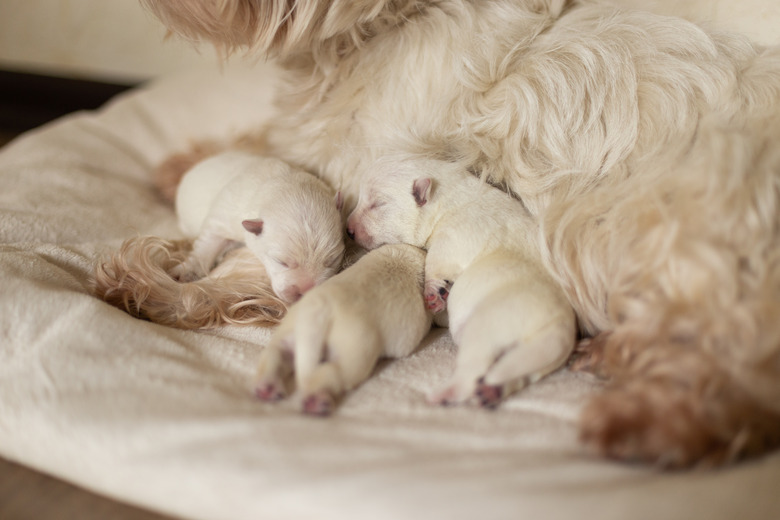How Do Dogs Give Birth To Puppies?
For optimal health, all female dogs should be spayed. Spaying is also vital to alleviating animal overpopulation and homelessness. Accidental pregnancies can occur if a dog has an unknown spay history and has not seen a veterinarian or when a female dog who is not spayed isn't kept away from intact male dogs. Dogs are mammals, and the birth of a dog is a similar process to other mammals. Litters can range from one to 12 puppies, with an average size of five to six.
Before a dog gives birth
Before a dog gives birth
A pregnant dog needs more food than usual and routine moderate, low-stress exercise. She will need regular veterinary checkups. She'll begin to gain weight, especially around her stomach. Some nausea and appetite loss, similar to morning sickness in humans, can occur around three weeks into pregnancy. If these symptoms persist for more than a week or if your dog is lethargic, consult your veterinarian.
The gestation period — the time from conception, or breeding, until birthing — depends on the breed and litter size. When do dogs give birth? Labor typically occurs 58 to 68 days after conception.
As the time to give birth, or whelp, approaches, the dog will look for a quiet, dark, soft place. She may even pick out the place a couple of weeks before labor begins. Twelve to 24 hours before labor, she loses her appetite and becomes very restless. Her rectal temperature drops to below 100 degrees 24 hours before labor.
How do dogs give birth?
How do dogs give birth?
The whelping process lasts six to 12 hours. During stage one, the cervix becomes fully dilated. Dogs may pant, pace, vomit, dig, or shiver during this time. Dogs should have plenty of water available throughout the process.
The actual delivery occurs in stages two and three of labor. The puppies are born, and as they pass through the vulva, the placenta is expelled. The mother will lick off the afterbirth, or membrane, covering the puppy. The hormones in the afterbirth are actually beneficial to the mother's production of milk. The mother dog will also normally sever the umbilical cord herself.
After each puppy is born, the mother will strain for 10 to 30 minutes before the next puppy is delivered. Puppies are usually delivered every 45 to 60 minutes. However, mother dogs may take a break of up to four hours between puppies and then resume labor. Timing can depend on the breed. While your dog may want some amount of privacy during labor, it's best to be observant to watch for any birthing complications.
Some sources that you may find online suggest pulling a stuck puppy from the birth canal. That is a situation that should be handled by a veterinarian because doing so could cause injury to the mother dog and/or the pup. However, if you are in an emergency situation and you can't get to a veterinarian quickly, action like that may be useful.
When Caesarean sections are necessary for dogs
When Caesarean sections are necessary for dogs
Several breeds of dogs have problems giving birth vaginally and usually need to have a Caesarean section. These breeds include the bulldog, Boston terrier, Pomeranian, vizsla, toy poodle, and Chihuahua. Many of them have been bred to have abnormal body types or features that make natural births impossible. Consult with your veterinarian to determine the best time to schedule a Caesarean section.
Dogs suffering from uterine rupture, dystocia, or another medical problem may also need a Caesarean if the puppies and the mother have any hope of surviving. This procedure is done under general anesthesia to open up the uterus and remove the puppies and placentas manually. When the puppies are removed, the dog should also be spayed. Dystocia is an indication that the dog should not give birth again.
After a Caesarean section, mother dogs need a few hours to recover from anesthesia. Puppies should not be left alone with the mother until she can stand up on her own.
Risks and warning signs during dog labor
Risks and warning signs during dog labor
Many dogs are able to whelp without any help from people, but complications can occur. Contact your veterinarian immediately in any of the following instances:
- The dog experiences 30 to 60 minutes of contractions with no
puppy coming out. - A puppy is stuck in the birth canal and the mother is unable to deliver.
- More than four hours pass with no straining or puppy
delivered when it is known that more puppies are still inside. - Labor doesn't
start 24 hours after the rectal temperature has dropped. - The dog is in pain.
- More
than 70 days of gestation have passed without the dog going into labor.
Green discharge indicates that a placenta has separated from the uterus. If a puppy is not delivered within 30 minutes of seeing green discharge, this is another reason to contact your veterinarian.

